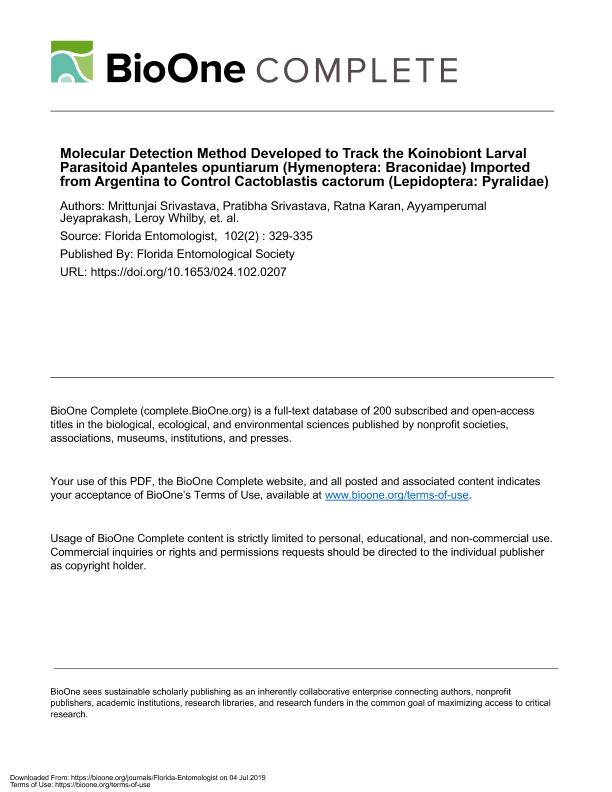Artículo
Apanteles opuntiarum Martínez & Berta (Hymenoptera: Braconidae) is a native natural enemy of the cactus moth, Cactoblastis cactorum Berg (Lepidoptera: Pyralidae) in Argentina, where the 2 species are believed to have co-evolved. Cactoblastis cactorum is an established invasive pest in the US that is rapidly spreading throughout the southeast. Apanteles opuntiarum was imported from Argentina, and reared at the Division of Plant Industry containment facility in Gainesville, Florida, for study as a possible biocontrol agent for release in the US to control C. cactorum. A DNA barcode was developed to enable the identification of the reared parasitoid population. The mitochondrial cytochrome oxidase I (COI) gene of the A. opuntiarum reared in Florida containment was found to be identical to its Argentine founders, but distinctly different from the COI sequences of all other reported Apanteles species in the NCBI (National Center for Biotechnology Information) GenBank. Additionally, the AoF1 and AoR1 primer pair developed in this study specifically amplified the COI gene of A. opuntiarum, but did not amplify the COI gene of the host C. cactorum. Therefore, the COI gene fragment identified in this study has the potential to be used as a DNA barcode specific to A. opuntiarum that can aid in tracking and identifying this parasitoid inside hosts. Apanteles opuntiarum Martínez & Berta (Hymenoptera: Braconidae) es un enemigo natural de la polilla de la tuna Cactoblastis cactorum Berg (Lepidoptera: Pyralidae) en Argentina, su rango nativo, donde han co-evolucionado. Cactoblastis cactorum es una especie invasora establecida en Estados Unidos, que se está dispersando rápidamente hacia el sudeste de este país. Apanteles opuntiarum fue importado desde Argentina y es criado en la cuarentena de Gainesville, Florida (Division of Plant Industry), donde está siendo evaluado como posible agente de control de C. cactorum, para ser liberado en Estados Unidos. Se desarrolló un código de barras de ADN para permitir la identificación de la población de parasitoides criada. Se encontró que el gen de la citocromo oxidasa mitocondrial I (COI) de los A. opuntiarum criados en Florida fue idéntico al de sus fundadores argentinos, y claramente diferente de las secuencias de COI de todas las demás especies de Apanteles reportados en el GenBank del NCBI (Centro Nacional de información sobre biotecnología). Además, el par “primer” AoF1 y AoR1 desarrollado en este estudio amplificó específicamente el gen COI de A. opuntiarum, y no amplificó el gen de la COI del hospedador C. cactorum. Por lo tanto, el fragmento del gen COI identificado en este estudio tiene el potencial para ser utilizados como un código de barras de ADN específico para A. opuntiarum que puede ayudar en el seguimiento y la identificación de este parasitoide dentro de los hospedadores
Molecular Detection Method Developed to Track the Koinobiont Larval Parasitoid Apanteles opuntiarum (Hymenoptera: Braconidae) Imported from Argentina to Control Cactoblastis cactorum (Lepidoptera: Pyralidae)
Srivastava, Mrittunjai; Srivastava, Pratibha; Karan, Ratna; Jeyaprakash, Ayyamperumal; Whilby, Leroy; Rohrig, Eric; Howe, Amy C.; Hight, Stephen D.; Varone, Laura

Fecha de publicación:
14/06/2019
Editorial:
Florida Entomological Society
Revista:
Florida Entomologist
ISSN:
0015-4040
Idioma:
Inglés
Tipo de recurso:
Artículo publicado
Clasificación temática:
Resumen
Palabras clave:
BIOLOGICAL CONTROL
,
COI GENE
,
DNA BARCODE
,
HOST RANGE TESTS
,
OPUNTIA
,
PARASITOIDS
Archivos asociados
Licencia
Identificadores
Colecciones
Articulos(SEDE CENTRAL)
Articulos de SEDE CENTRAL
Articulos de SEDE CENTRAL
Citación
Srivastava, Mrittunjai; Srivastava, Pratibha; Karan, Ratna; Jeyaprakash, Ayyamperumal; Whilby, Leroy; et al.; Molecular Detection Method Developed to Track the Koinobiont Larval Parasitoid Apanteles opuntiarum (Hymenoptera: Braconidae) Imported from Argentina to Control Cactoblastis cactorum (Lepidoptera: Pyralidae); Florida Entomological Society; Florida Entomologist; 102; 2; 14-6-2019; 329-335
Compartir
Altmétricas



